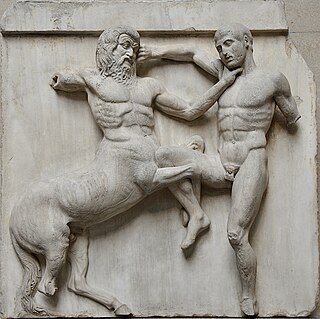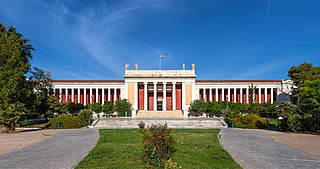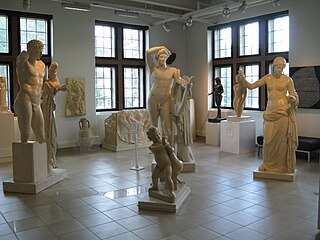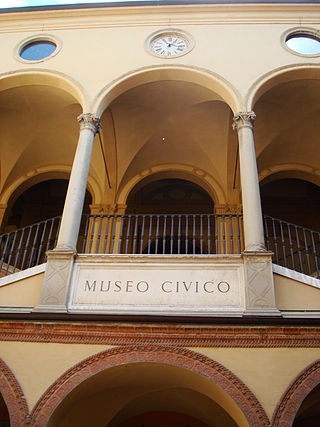
The Ny Carlsberg Glyptotek, commonly known simply as Glyptoteket, is an art museum in Copenhagen, Denmark. The collection represents the private art collection of Carl Jacobsen (1842–1914), the son of the founder of the Carlsberg Breweries.

Pontic Olbia or simply Olbia is an archaeological site of an ancient Greek city on the shore of the Southern Bug estuary in Ukraine, near the village of Parutyne. The archaeological site is protected as the National Historic and Archaeological Preserve. The preserve is a research and science institute of the National Academy of Sciences of Ukraine. In 1938–1993 it was part of the NASU Institute of Archaeology as a department.

Antiquities are objects from antiquity, especially the civilizations of the Mediterranean: the Classical antiquity of Greece and Rome, Ancient Persia (Iran), Ancient Egypt and the other Ancient Near Eastern cultures. Artifacts from earlier periods such as the Mesolithic, and other civilizations from Asia and elsewhere may also be covered by the term. The phenomenon of giving a high value to ancient artifacts is found in other cultures, notably China, where Chinese ritual bronzes, three to two thousand years old, have been avidly collected and imitated for centuries, and the Pre-Columbian cultures of Mesoamerica, where in particular the artifacts of the earliest Olmec civilization are found reburied in significant sites of later cultures up to the Spanish Conquest.

The National Archaeological Museum in Athens houses some of the most important artifacts from a variety of archaeological locations around Greece from prehistory to late antiquity. It is considered one of the greatest museums in the world and contains the richest collection of Greek Antiquity artifacts worldwide. It is situated in the Exarcheia area in central Athens between Epirus Street, Bouboulinas Street and Tositsas Street while its entrance is on the Patission Street adjacent to the historical building of the Athens Polytechnic university.

The Peshawar Museum is a museum located in Peshawar, capital of Pakistan's Khyber Pakhtunkhwa province. The museum houses a collection of Buddhist artwork from the ancient Gandhara region.
The Antikythera wreck is a Roman-era shipwreck dating from the second quarter of the first century BC.

The Allard Pierson Museum is the archaeological museum of the University of Amsterdam. It is situated at the Oude Turfmarkt 127 in Amsterdam, the Netherlands. Artifacts from the ancient civilizations of ancient Egypt, the Near East, the Greek World, Etruria, and the Roman Empire are curated and exhibited in this museum.

Moesgaard Museum (MOMU) is a Danish regional museum dedicated to archaeology and ethnography. It is located in Beder, a suburb of Aarhus, Denmark.

The Museum of Byzantine Culture is a museum in Thessaloniki, Central Macedonia, Greece, which opened in 1994.

The Archaeological Museum of Komotini is a museum on Symenonidi Street in Komotini in Greece. The museum was designed by Aris Konstantinidis, an architect, and was commissioned in 1976. The exhibits on display are from the Neolithic to the Byzantine period, from the excavations of the Thracian archaeological sites, and reveal much about the prehistory and history of Western Thrace and Komotini. The museum also has exhibits of folklore art, agriculture operations and basket making.

The History Museum of Armenia is a museum in Armenia with departments of Archaeology, Numismatics, Ethnography, Modern History and Restoration. It has a national collection of 400,000 objects and was founded in 1920. Of the main collection, 35% is made up of archaeology-related items, 8% is made up of ethnography-related items, 45% is made of numismatics-related items, and 12% is made up of documents. It is regarded as Armenia's national museum and is located on Republic Square in Yerevan. The state financially supports the museum and owns both the collection and the building. The museum carries out conservation and restoration work and publishes works on Armenian architecture, archaeology, ethnography, and history. They also have published a series of reports on archaeological excavations since 1948. The museum carries out educational and scientific programs on Armenian history and culture as well.
The Departmental Museum of archaeology Gilort (Jérôme) Carcopino is situated in the commune of Aleria in Corsica (France) at around 70 kilometers from Bastia and at 120 kilometers from Ajaccio.

The Museum of Antiquities is an archaeological museum at the University of Saskatchewan in Saskatoon, Canada. It opened in 1974 to provide an opportunity to study ancient works. The museum currently features a variety of Greek and Roman sculpture, and contains a collection of Near Eastern, Egyptian, Byzantine, Islamic and Medieval art. It is one of only a handful of museums of its kind in Canada.

The National Museum of Denmark (Nationalmuseet) in Copenhagen is Denmark's largest museum of cultural history, comprising the histories of Danish and foreign cultures, alike. The museum's main building is located a short distance from Strøget at the center of Copenhagen. It contains exhibits from around the world, from Greenland to South America. Additionally, the museum sponsors SILA - The Greenland Research Center at the National Museum of Denmark to further archaeological and anthropological research in Greenland.

The Casts Museum occupies two rooms in the basement of the new building of the School of Philosophy of the Aristotle University of Thessaloniki, in Central Macedonia, Greece. The museum houses a collection of plaster casts, replicas and original archaeological artifacts. The collection dates from the time of the University's founding and is due to K. Romaio, Professor of Classical Archaeology.

The Archaeological Civic Museum of Bologna is located in the fifteenth-century Palazzo Galvani building at Via dell'Archiginnasio 2 postal code 40124 Bologna, once known as the Hospital of Death. Founded in September 1881 by the merging of two separate museums: the one belonging to the University of Bologna – heir of the Room of Antiquity belonging to the Academy of Sciences founded by Luigi Ferdinando Marsili in (1714) – and that belonging to the City of Bologna (enriched by the antique collection of Artist Pelagio Palagi and the large amount of finds from excavations conducted in and around Bologna during these times.

Alanya Archaeological Museum is an archaeological museum in Alanya, Turkey. The museum is divided into two sections, with displays of archaeological and ethnographic artifacts. It contains numerous ceramic, marble, bronze and glass pieces and mosaics from the Hellenistic, Roman, and Byzantine periods. Of particular note is its 2nd century bronze statue of Hercules, which measures 52 centimetres (20 in) in height. The museum, which was established in 1967, was refurbished in 2012.

Konya Archaeological Museum is a state archaeological museum in Konya, Turkey. Established in 1901, it had been relocated twice before moving to its present location in 1962. One of the most prominent displays in the museum is of sarcophagi and other antiquities from the ancient city of Çatalhöyük. Other exhibits relate to the Neolithic, Bronze Age, Iron Age, Classical, Hellenistic, Roman and the Byzantine periods; artifacts consist of ceramic ware, stone and bronze wares, ornaments and inscriptions. Among the objects displayed is a marble sarcophagus of the 3rd century AD, with elaborate relief sculptures depicting the life of Hercules. In the outer open yard of the museum there are a number of small sculptures, sarcophagi, column capitals, and samples of epigraphy.

The Biblioteca Oliveriana is a public library located in the Palazzo Almerici on via Mazza in the town of Pesaro, region of Marche, Italy. It shares the building with the Museo Oliveriano, an archaeology museum with which it shares a common history.
Rubina Raja is a classical archaeologist educated at University of Copenhagen (Denmark), La Sapienza University (Rome) and University of Oxford (England). She is professor (chair) of classical archaeology at Aarhus University and centre director of the Danish National Research Foundation's Centre of Excellence for Urban Network Evolutions (UrbNet). She specialises in the cultural, social and religious archaeology and history of past societies. Research foci include urban development and network studies, architecture and urban planning, the materiality of religion as well as iconography from the Hellenistic to Early Medieval periods. Her publications include articles, edited volumes and monographs on historiography, ancient portraiture and urban archaeology as well as themes in the intersecting fields between humanities and natural sciences. Rubina Raja received her DPhil degree from the University of Oxford in 2005 with a thesis on urban development and regional identities in the eastern Roman provinces under the supervision of Professors R.R.R. Smith and Margareta Steinby. Thereafter, she held a post-doctoral position at Hamburg University, Germany, before she in 2007 moved to a second post-doctoral position at Aarhus University, Denmark. In 2011–2016, she was a member of the Young Academy of Denmark, where she was elected chairwoman in 2013.


















